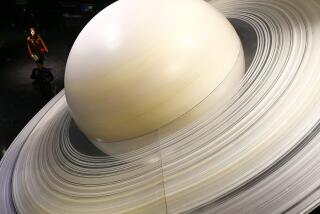Orbiting telescope spots possible planets
- Share via
In only its first 43 days of operation, NASA’s Kepler orbiting telescope has identified 706 potential planets circling other stars, the agency said Tuesday.
Although some are likely to be false positives that will be weeded out by further observation, the announcement could double the known number of so-called extrasolar planets, a figure that now stands at 461.
Significantly, many of the planets are the size of Earth or slightly larger, suggesting that they might be rocky, water-bearing locations where life could have evolved.
“This is the single largest announcement of planets that’s ever happened,” said Caltech astrophysicist John Johnson, who was not part of the team that made the announcement. “It’s definitely momentous.”
The announcement was accompanied by some controversy, however. The Kepler team, which is headquartered at NASA’s Ames Research Center in Northern California, made public the data on only 306 of the potential planets. That information was presented in a paper posted on the astrophysics pre-publication website arXiv.org.
The data about the best 400 candidates were kept confidential by the team members, giving them a chance to confirm that each sighting actually is a planet, a process that requires ground-based observations. Other teams cannot verify the potential planets without knowing their location.
Normally, NASA requires that data collected from its orbiting observatories or other missions be released quickly. But the Kepler team argued that delays in the launch and other problems have limited its ability to follow up on the sightings. In particular, the region of space occupied by the potential new planets is visible only from ground-based observatories during the summer, so team members have not yet had a chance to verify the data.
NASA had earlier extended the period during which the data could be kept confidential while the team worked out data processing problems. All of the withheld data will be made public in six months, NASA said, with additional data released quarterly.
“I’m somewhat ambivalent about that,” said astrophysicist B. Scott Gaudi of Ohio State University, who was not part of the team. “The sooner the data gets out there, the more eyes that will see it. On the other hand, the discovery of an Earth-sized planet is a really big deal, not the kind of thing you want to have reported incorrectly.”
Added Johnson: “Nobody likes to wait, particularly when you could get your hands on history-changing data.”
Kepler, launched from Cape Canaveral, Fla., in March 2009, carries a 55-inch mirror, whose field of view is about 33,000 times wider than that of the Hubble Space Telescope. From its orbit above the Earth, it focuses constantly on an area of the sky near the constellations Cygnus and Lyra, near the plane of the Milky Way. That area encompasses about 105 square degrees — a small fraction of the sky.
The team is studying about 150,000 sun-like stars in this region out of a total of 4.5 million; those stars are from tens of light-years to 3,000 light-years away. Kepler photographs them every 30 minutes, looking for the minute variations in light output that might indicate an orbiting planet has passed between the individual stars and Earth. The telescope will monitor the same region for at least three years.
In doing so, it will provide multiple observations of planets with short orbital periods, or years, and it will detect those with longer years that don’t often pass between their stars and Earth.
The telescope will detect only those planets whose orbits put them between the targeted stars and Earth. Because these systems account for but a small segment of the heavens, the ultimate data could suggest that the actual number of planets in the cosmos is immense.
Most of the smaller potential planets observed so far have short orbital periods and are relatively close to their stars.
“That’s a good sign if you are an observer,” Johnson said, “but perhaps a bad sign if you are a theorist.” The consensus among theorists has been that most planets should be farther out from their stars. “There is supposed to be a planet desert in this region.”






